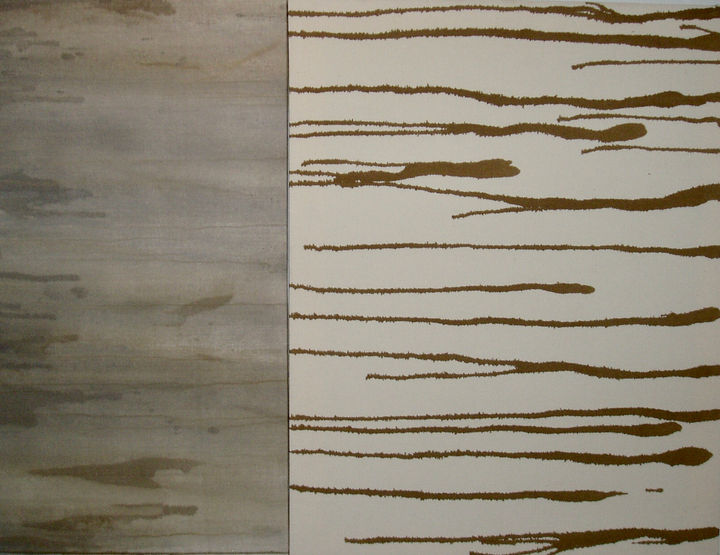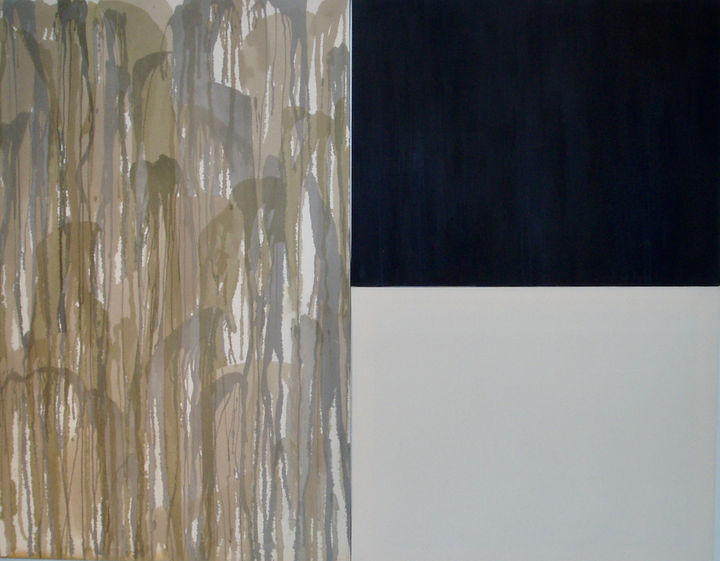The Dematerialization of Painting
This body of work was created as the result of a line of a line of enquiry in which my practice developed from a traditional 'pictorial' response to landscape into that, which became entirely self-referential, and process based.
My concerns became almost entirely subjective and lay within the actual physical construction of the work. I became interested in how the paintings developed to reveal themselves to the viewer as actual objects inhabiting 3 dimensional space; the paint marks on the surface being read as the results of an experience lived and no longer as a record of something seen or imagined.
The processes outlined formed the core material for my M.A in Fine Art. See below for an extract from an essay explaining further the development of my practice during this time.
The Dematerialization of Painting - A Critical Appraisal
The move towards a more abstract approach first began in 2003 during my time studying for an MA in Fine Art at The University of Gloucestershire, Cheltenham. The works selected for this exhibition were produced during that time so for the purpose of this statement it is important for me to reflect upon that period of my working practice and the subsequent development, which ensued.
From the outset I was urged to view my work objectively leading me to question the validity of its formal elements, which at that time consisted of a varied use of colour, a mixed media approach to materials - with the inclusion of found objects and surface texture - a pictorial approach to composition executed in a range of formats which included portrait and more obviously landscape and an approach to scale and perspective encompassing both the macro and micro.
On reflection it was clear that the works of that time were seeking to become an embodiment of those elements commonly found in landscape such as colour, texture, scale, as well as combining both abstract and pictorial perspectives. However due to their complexity I felt them to be unsuccessful in capturing the true essence of the subject. I learned how through a process of deconstruction it would be possible to tease out the strands of each individual element in order to then further expand upon and develop what was most important in my response to landscape.
I began by questioning my use of the medium and initially made considerable changes to the areas of both and texture and colour. Questioning the relevance of texture in my work led me to an analysis of scale and the micro / macro issue. For a long time my work was concerned primarily with my interest in the microcosm. I sought to mirror the complexities of the earth's surface through my use of paint and the addition of a variety of textures both natural and man- made. I then attempted a dramatic shift in perspective to encompass a much more macrocosmic view of landscape yet I still found myself needing to add a textured surface to the painting which when questioned seemed to have little or no purpose whatsoever. It was not part of the painterly process and was irrelevant to the subject, which was no longer about surface but concerned with more spatial elements. So why was I still so preoccupied with using it? The answer came when I was forced to stand back and look objectively at the paintings; their surface texture was for me clearly their most compelling element. This brought me to realise immediately that this preoccupation with surface strongly suggested that my true interest in landscape was to be found in the microcosm.
Having come to this important conclusion about where my interests lay I continued to question my use of texture. Firstly in terms of its application, I began to look at ways of making its usage much more integral to the process of painting itself and secondly its overall relevance to the subject matter. For example, I made two paintings both of which were microcosmic sections of sandy beach, I stopped sticking heavy texture to the surface of the canvas with PVA and then painting over the top of it and instead began incorporating much more finely ground texture with the paint, which I then painted onto the canvas in the usual way. The act of doing this made me feel as though I was in some way actually 'making' a beach bringing to light a previous concern I had about recreating the processes of the formation of landscape in my work. In this particular case I used sand taken from the actual beach in question. This raised the issue of a possible conceptual use of texture in my work, which has been something of a consideration in the past but was no longer of particular relevance to me.
Later I became less interested in building up a surface using the addition of texture and more interested in the effects I could achieve through the layering of paint. I worked off the canvas in a much less controlled way tipping and dribbling paint and water onto the surface. This process had the effect of staining and layering paint into and onto the canvas and the results were very interesting and very random as if left to nature itself. It also had the effect of giving the work a lot more depth, to the extent that it really drew the viewer in.
The chance element involved in the making of my work became increasingly important to me and led me to look at the scientific theory surrounding how the principles of nature govern chance occurrences. This was a way into understanding further and in a sense finding some kind of justification for the possibility that my working processes were to an extent reflective of those forces at work in nature. It also clarified an ongoing concern I had about patterns and forms found in the microcosm repeating themselves in the macrocosm despite the vast differences in scale.
My decision to use a very limited colour palette also came at this time and the discipline of using just Raw Umber and Ultramarine (which when mixed together make black) enabled me to stay focused on my main concerns, which lay in the actual physical construction of the paintings. Any more colour was too distracting and without it I was encouraged to find more variation in the way that I applied the pigment.
These simple changes impacted enormously on the works produced at that time and I discovered an immense sense of freedom as a result of the discipline of limitation.
The initial works were clearly very reflective of the processes at work in nature - the sea washing over the sand leaving a variety of marks. Over time these processes became fully translated into the language of painting resulting in their titles becoming descriptive of the processes involved in their construction for example Diptych and Revealed Painting.
One of my objectives at the beginning of the course had been to free my work entirely from the pictorial conventions of landscape painting whilst remaining firmly rooted in the subject. I believe I achieved this and through it discovered new directions in which to take the work as well as learning a few fundamental things about painting. For example I was made aware that nothing is more suggestive of landscape in a painting than its basic format so in the new works I used mostly a square as it totally frees the viewer of any preconceptions they may have about the subject matter. I also discovered how the decisions made about the presentation of the edges of the work impact upon the viewer's reading of it and therefore greatly influence their overall experience of it. For example, by continuing the painting around the edge of the stretcher the work becomes less the projection of a picture from a flat surface and much more of a 3D object. This coupled with a square format which greatly influences the containment of energy within the work can have an enormously engaging effect on the viewer encouraging them to enter into a personal dialogue with the work with whom they inhabit the same space. Using a large rectangular frame in portrait format I found to have a similar effect as it mirrors the dimensions of the human form.
The coast marks the edge of the land, the boundary between land, sea and sky, which I understand through my own work to be metaphorical of the boundary between human mental and physical experience. Thinking in this way about how the paintings were perceived led me to question two more fundamentals. Firstly scale, It was important that the works became larger than the viewer in terms of scale in order to make the viewer aware of their own body and therefore provoke a bodily response from them, secondly how the works were hung in the space would make the viewer aware of the space that they themselves were occupying. For the work to evoke a physical response from the viewer in this way was very important to me as I wanted them to experience it as they experienced being out in the landscape.
These concerns are those common to sculptors, which led me to question the boundaries of a painting, and when and to what extent it dematerializes and becomes something else.
Extract taken from "Painting a Question of Confidence", published to accompany the exhibition at University Centre Milton Keynes Gallery 2010.




